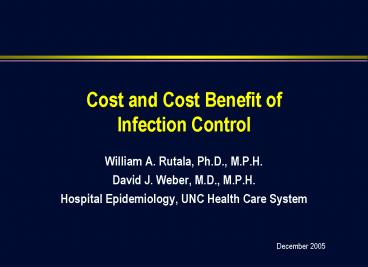Cost and Cost Benefit of Infection Control PowerPoint PPT Presentation
1 / 18
Title: Cost and Cost Benefit of Infection Control
1
Cost and Cost Benefit of Infection Control
- William A. Rutala, Ph.D., M.P.H.
- David J. Weber, M.D., M.P.H.
- Hospital Epidemiology, UNC Health Care System
December 2005
2
Topics
- Minimal IC Program staffing
- 1 ICP 150 adjusted occupied beds
- Mandatory CBIC certification
- Legislative bill, that the Health Commission
adopt rules to establish staff qualifications
including professional requirements for hospital
staff, did not pass
3
Healthcare-Associated Infections (HAIs)
- HAIs are those that develop in the hospital that
were neither incubating nor present at the time
of admission - 40 million persons hospitalized annually in US
5 or 2 million will develop a HAI - Morbidity and mortality (90,000 deaths)
- Variable prolongation of hospital stay
- Total annual hospital-related financial
burden-6.5 billion
4
Cost of Infection Control
- Cost of infection control borne by hospitals
- Under modern payment systems, hospitals reap the
financial benefits associated with decreased HAI - Fixed reimbursement based on diagnosis transfers
the risk from payer to hospital - Complications that slow discharge and consume
resources are only partially reimbursed at best - Thus, HAIs cost hospitals money
5
Cost of Infection Control
- In addition to the economic incentive, hospitals
have a fiduciary charge to provide high-quality
patient care - To the extent, HAIs are preventable, HAIs
represent defects in patient care - Thus, infection control is in the enviable
position of saving money while simultaneously
improving the quality of care
6
Cost of Infection Control
- Against this background, many infection control
programs are neither well funded nor highly
valued in their institutions - Savings due to averted infections are often
poorly understood or ignored
7
Cost of Infection Control
- Another problem is that infection control
programs are not standardized - A survey of 45 university-affiliated hospitals
showed a median of 1 ICP per 137 beds - NNIS hospitals have 1 ICP per 123 beds
- 0.8-1.0 ICP for every 100 beds suggested by
Delphi panel - High quality IC programs require substantial time
to review reports, conduct surveillance, educate
staff, evaluate outbreaks, participate in
committees, ensure that regulatory requirements
are met, and most importantly, prevent HAIs.
8
Cost of Healthcare-Associated Infections
9
Costs of an Infection Control Program300-Bed
Hospital
10
Cost-Benefit Assessment of Infection Control
Programs
- SENIC found that 32 of HAIs can be prevented by
effective infection control programs - Hospitals without effective programs actually had
a rise in HAIs from 9 to 31, but effective
programs reduced HAI rates from 7 to 48 in the
same period - Based on SENIC findings, a hypothetical hospital
would have 713 infections/year without an
effective program but 487 infections with an
effective program
11
Cost-Benefit Assessment of Infection Control
Programs
- An effective program would save the hospital
about 900,000 annually - This projection uses very conservative estimates
of the excess costs resulting from HAIs - The infection control program costs for a 250-bed
hospital would be less than 250,000 - Preventing HAIs is cost-beneficial with an
estimated savings of 650,000 annually
12
Cost Per Year of Life Saved
13
New Frontiers
- Emphasis on patient safety
- Lack of treatment for new pathogens (e.g., SARS)
- Move from inpatient to outpatient environment
- Increase in population age
- Persons gt65yo numbered 36 million in 2004 and by
2030 there will be 72 million - Increase in antimicrobial resistance (e.g., MRSA)
14
Traditional ICP Activities
- Surveillance
- Outbreak investigations
- Policy development and implementation
- Environmental/infection control rounds
- Education (infection control, bloodborne
pathogen, TB) - Regulatory compliance
- Committee participation
15
New ICP Responsibilities
- Increased regulations (OSHA, FDA)
- Emerging pathogens (avian influenza)
- IHI campaign
- Increase training/education requirements
- Post-exposure prophylaxis (HIV, HBV)
- Epidemiologic typing of outbreak pathogens
- Interpreting screening cultures (MRSA, VRE)
- Risk adjusted surveillance (SSI, CR-BSI, VAP)
- Sentinel event analysis
16
Summary
- Increase infection control resources are a
win-win-win investment - Reduced patient morbidity and mortality
- Net cost savings to institution, society and
patient - Improve patient satisfaction
- From the standpoint of the hospital and society,
the benefits exceed the costs - Hospitals should support a ratio of ICP per beds
of 1150
17
Thank you
18
References
- Nettlemen MD. Cost and cost benefit of infection
control. In Wenzel RP. Prevention and Control of
Nosocomial Infections, 2003 - Dixon RE. Cost of nosocomial infections and
benefits of infection control programs. In Wenzel
RP. Prevention and Control of Nosocomial
Infections, 1987 - Wenzel RP. The economics of nosocomial
infections. J Hosp Infect 19953179 - Burke JP. Infection control-A problem for patient
safety. NEJM 20033487. - OBoyle C. et al. Am J Infect Control 2002
30321

